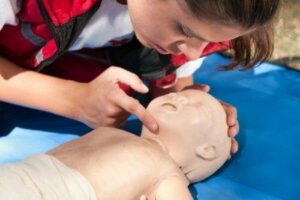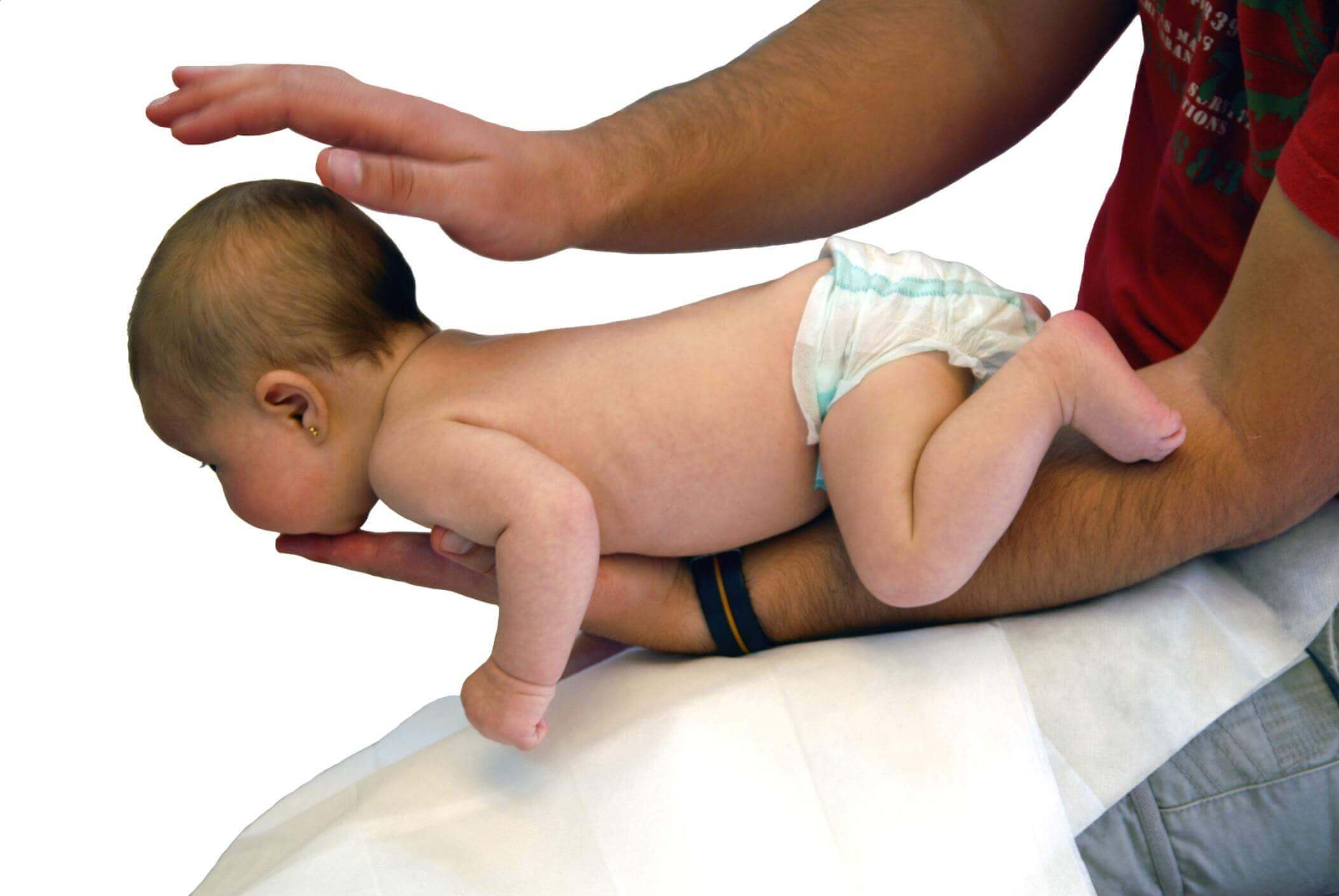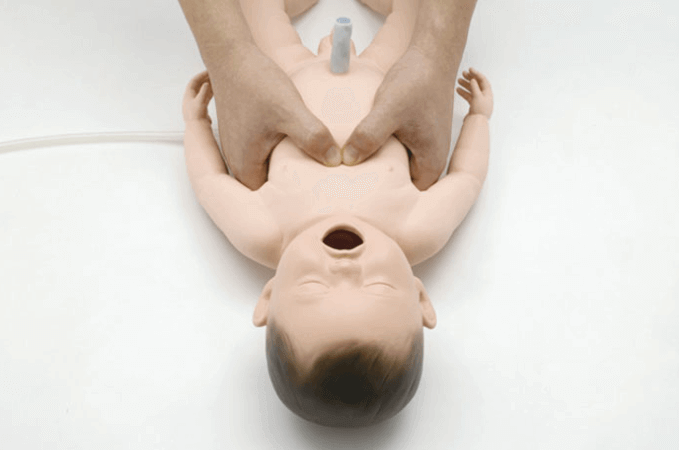How to Resuscitate a Baby After an Accident

Do you know how to resuscitate a baby after an accident? You never know when you’re going to face a child who’s suffered some mishap or chokes and stops breathing. Therefore, it’s good for your to know some key maneuvers when helping them so you can be prepared at all times. If the case is a blow to the head or an accident, the child may need first aid such as resuscitation or cardiac massage, and each of these has its peculiarities.
The resuscitation maneuver may harm them if they’re still breathing, so make sure that they’re not before proceeding. To do this, observe for ten seconds to see if their chest moves. You can also bring your cheek to their mouth to verify if air is going in and out.
Before starting the maneuver, make sure that no one around you is disturbing you. Your space must be free and clear.
If your intention is to know if the child is conscious, you can do it by gently shaking them. Don’t be too forceful as that can be traumatic for the child. Just nudge them enough to see if they respond or put your finger under their nose to check. And if they’re passed out, then ask someone to help you by placing them on a hard surface on their back and with their body stretched out.
Then, place your hand on their forehead to support their head and force their chin to rise. With two fingers of the other hand, hold their chin and open their mouth. If the baby is less than one year old, then give them five breaths. Blow air into their mouth and nose at the same time for one second five times. Then see if it works.

If the child doesn’t respond, give them a heart massage. Do 30 compressions with your index and middle fingers in the lower third of the sternum–that’s about one finger below the line of the nipples. Then, do two mouth-to-mouth breaths and another 30 heart massages.
If the child’s older than one year, then clamp their nose with your thumb and index finger and hold his mouth open with the other hand. Do 5 breaths of one second each by blowing air into their mouth. See if there are any changes. If the child doesn’t respond, give 30 compressions to the lower third of the sternum with the pad of the palm of your hand.
How to Resuscitate an Older Child
If the child is older and strong, press with both hands, putting the pad of one hand over the other. Squeeze to sink a third of the width of the thorax. Next, do two mouth-to-mouth ventilations, followed by 30 chest compressions. If you’re alone with the child, do these maneuvers for a minute. Then you can take a moment to call for help.
You can start resuscitation with a cardiac massage, skipping the first five breaths. The most important thing is to follow the sequence of 30 compressions for every two breaths.
It’s important to know that the compressions should have a constant rhythm and be quite fast, such as three sequences of 30/2 per minute. You should stop if you see that the child begins to breathe or when you feel very tired.
If you’re alone with the child, do these maneuvers for a minute. Then you can take a moment to call or ask for help. Quick action is the key to resuscitating the child. Knowing the right information and the best way to proceed is an advantage when dealing with these cases.
In an accident, it’s vital that you take action and know how to resuscitate a child

Accidental shock is the state prior to cardiac arrest. It occurs when, for various reasons, the child doesn’t receive enough oxygen. It’s a very serious situation, which requires immediate attention. For that reason, it’s very important to recognize the signs.
For example, look at the child’s appearance. When they’re in a state of shock, don’t have a good skin tone, don’t respond to stimuli, don’t look if you speak to them, are inconsolable, very agitated, and have more heartbeats than normal.
You can also check their breathing. Notice if they’re racing or have trouble breathing and making noises.
To help better, let the signs you observe be your guide. If they breathe fast but without difficulty, take them to the emergency room. If they have trouble breathing or make noises and are pale, call an ambulance.
Now, you know how to resuscitate a child. However, the best thing you can do is to find a First Aid/CPR course in your area and become certified by professionals.
Do you know how to resuscitate a baby after an accident? You never know when you’re going to face a child who’s suffered some mishap or chokes and stops breathing. Therefore, it’s good for your to know some key maneuvers when helping them so you can be prepared at all times. If the case is a blow to the head or an accident, the child may need first aid such as resuscitation or cardiac massage, and each of these has its peculiarities.
The resuscitation maneuver may harm them if they’re still breathing, so make sure that they’re not before proceeding. To do this, observe for ten seconds to see if their chest moves. You can also bring your cheek to their mouth to verify if air is going in and out.
Before starting the maneuver, make sure that no one around you is disturbing you. Your space must be free and clear.
If your intention is to know if the child is conscious, you can do it by gently shaking them. Don’t be too forceful as that can be traumatic for the child. Just nudge them enough to see if they respond or put your finger under their nose to check. And if they’re passed out, then ask someone to help you by placing them on a hard surface on their back and with their body stretched out.
Then, place your hand on their forehead to support their head and force their chin to rise. With two fingers of the other hand, hold their chin and open their mouth. If the baby is less than one year old, then give them five breaths. Blow air into their mouth and nose at the same time for one second five times. Then see if it works.

If the child doesn’t respond, give them a heart massage. Do 30 compressions with your index and middle fingers in the lower third of the sternum–that’s about one finger below the line of the nipples. Then, do two mouth-to-mouth breaths and another 30 heart massages.
If the child’s older than one year, then clamp their nose with your thumb and index finger and hold his mouth open with the other hand. Do 5 breaths of one second each by blowing air into their mouth. See if there are any changes. If the child doesn’t respond, give 30 compressions to the lower third of the sternum with the pad of the palm of your hand.
How to Resuscitate an Older Child
If the child is older and strong, press with both hands, putting the pad of one hand over the other. Squeeze to sink a third of the width of the thorax. Next, do two mouth-to-mouth ventilations, followed by 30 chest compressions. If you’re alone with the child, do these maneuvers for a minute. Then you can take a moment to call for help.
You can start resuscitation with a cardiac massage, skipping the first five breaths. The most important thing is to follow the sequence of 30 compressions for every two breaths.
It’s important to know that the compressions should have a constant rhythm and be quite fast, such as three sequences of 30/2 per minute. You should stop if you see that the child begins to breathe or when you feel very tired.
If you’re alone with the child, do these maneuvers for a minute. Then you can take a moment to call or ask for help. Quick action is the key to resuscitating the child. Knowing the right information and the best way to proceed is an advantage when dealing with these cases.
In an accident, it’s vital that you take action and know how to resuscitate a child

Accidental shock is the state prior to cardiac arrest. It occurs when, for various reasons, the child doesn’t receive enough oxygen. It’s a very serious situation, which requires immediate attention. For that reason, it’s very important to recognize the signs.
For example, look at the child’s appearance. When they’re in a state of shock, don’t have a good skin tone, don’t respond to stimuli, don’t look if you speak to them, are inconsolable, very agitated, and have more heartbeats than normal.
You can also check their breathing. Notice if they’re racing or have trouble breathing and making noises.
To help better, let the signs you observe be your guide. If they breathe fast but without difficulty, take them to the emergency room. If they have trouble breathing or make noises and are pale, call an ambulance.
Now, you know how to resuscitate a child. However, the best thing you can do is to find a First Aid/CPR course in your area and become certified by professionals.
This text is provided for informational purposes only and does not replace consultation with a professional. If in doubt, consult your specialist.








